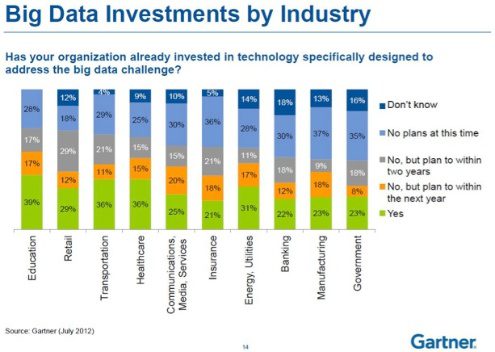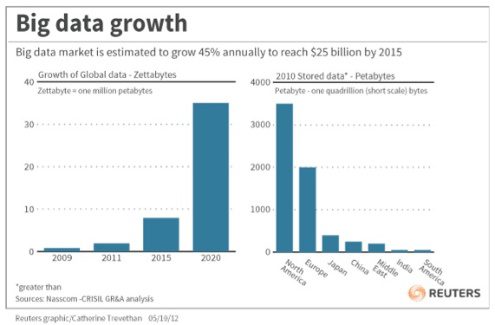Datamation content and product recommendations are
editorially independent. We may make money when you click on links
to our partners.
Learn More
Also see: Big Data Survey: Big Data Growing Quickly
Although the article is bit dated, this 2012 report from Gartner does a good job of defining the vertical market opportunities that existed in the emerging world of Big Data. As you can see in the first graphic below, all vertical markets had some interest in Big Data in 2012, with Education and Transportation having the highest percentage, and Insurance and Banking having the lowest. That always seemed a big backwards to me, but the core idea is that Big Data grew at different rates in each vertical industry because Big Data delivered different values for each vertical.

Gartner’s take on Big Data opportunity by industry in 2012.
About the same time as the Gartner report, Reuters provided some data that predicted the rapid growth of Big Data, as shown in Figure 2. For the most part, we’re on track with the Reuters numbers and should see the 45% annual growth that Reuters predicted, if you look at other analyst reports and take my own experience into consideration.

In 2012, Reuters predicted the rapid growth of Big Data. For the most part, we’re on track with these numbers.
More recent data includes an IDC study that predicts the market for Big Data to reach $16.1 billion in 2014, growing 6 times faster than the overall IT market. “IDC includes in this figure Infrastructure (servers, storage, etc., the largest and fastest growing segment at 45% of the market), services (29%) and software (24%).”
Most interesting was one prediction that the adoption of analytics-as-a-service will accelerate, and “ready-made analytics in the cloud” will make the use of Big Data more attractive and compelling. This would include the ability to define common vertical analytics that will be sold as part of Big Data technology, using cloud-based platforms as the way to distribute these analytics to end user organizations. That’s my assertion here, and seems to be an emerging and rapidly growing pattern.
Finally, IDC predicts that cloud infrastructure will be the fastest-growing sub-segment of the Big Data market, with a 2013-2017 CAGR of close to 50%. This means that cloud is driving Big Data, and vice versa. We’ve seen this happen for the last few years now.
So, where am I going with all of this? Moving forward, factors that will drive Big Data adoption include:
· The use of public cloud-based platforms. This will remove much of the risk of adopting Big Data systems, even amongst the most frugal vertical industries.
· Vertical market-focused features within Big Data systems, which will make the use of Big Data much more valuable in specific verticals. Despite what the Gartner report said in 2012, the majority of adopters now appear to be banks and other financial services firms, as being the largest users, with healthcare showing the highest percentage of growth.
· The ability to leverage cloud platforms as a single point of distribution for vertically-oriented features and facilities. This includes schemas to support specific vertical industries, as well as pre-built analytical services that focus on specific vertical processes and analytical requirements.
I’ve already encountered examples of all the above factors. There are now analytical services that focus on providing information about quality of care in the healthcare vertical. These services leverage local patient care data along with industry data provided by other data providers that allows healthcare providers to determine true quality of care information, as well as determine how their organization stacks up against other healthcare providers. This is all part of a canned report, and data set, specifically built for the healthcare vertical and is just one of hundreds of pre-built cloud-delivered analytics that are offered within vertical markets.
Most IT shops don’t think in these terms yet. However, end users continue to discover pre-existing and well-defined analytical services that exist in clouds, services that will finally allow them to get at the information they need. Much like the drive of “shadow IT” around cloud usage in the last few years, the pressure from end users toward pre-built and vertically-oriented Big Data analytics will force IT to provide access to these services. As a result, more reinvestment will go back into developing these services by the Big Data and cloud technology providers, and these tools will become even more valuable and useful.
This is happening now. Big Data continues to get, well, bigger, and cloud computing seems to be driving its use. The growth of specific vertical market features provided by Big Data systems, and typically delivered and enabled by the public cloud, will be what drives the use of Big Data going forward. The business case is just too compelling, and technology just too easy to leverage and deploy to make any other prediction.
Photo courtesy of Shutterstock.
-
Huawei’s AI Update: Things Are Moving Faster Than We Think
FEATURE | By Rob Enderle,
December 04, 2020
-
Keeping Machine Learning Algorithms Honest in the ‘Ethics-First’ Era
ARTIFICIAL INTELLIGENCE | By Guest Author,
November 18, 2020
-
Key Trends in Chatbots and RPA
FEATURE | By Guest Author,
November 10, 2020
-
Top 10 AIOps Companies
FEATURE | By Samuel Greengard,
November 05, 2020
-
What is Text Analysis?
ARTIFICIAL INTELLIGENCE | By Guest Author,
November 02, 2020
-
How Intel’s Work With Autonomous Cars Could Redefine General Purpose AI
ARTIFICIAL INTELLIGENCE | By Rob Enderle,
October 29, 2020
-
Dell Technologies World: Weaving Together Human And Machine Interaction For AI And Robotics
ARTIFICIAL INTELLIGENCE | By Rob Enderle,
October 23, 2020
-
The Super Moderator, or How IBM Project Debater Could Save Social Media
FEATURE | By Rob Enderle,
October 16, 2020
-
Top 10 Chatbot Platforms
FEATURE | By Cynthia Harvey,
October 07, 2020
-
Finding a Career Path in AI
ARTIFICIAL INTELLIGENCE | By Guest Author,
October 05, 2020
-
CIOs Discuss the Promise of AI and Data Science
FEATURE | By Guest Author,
September 25, 2020
-
Microsoft Is Building An AI Product That Could Predict The Future
FEATURE | By Rob Enderle,
September 25, 2020
-
Top 10 Machine Learning Companies 2020
FEATURE | By Cynthia Harvey,
September 22, 2020
-
NVIDIA and ARM: Massively Changing The AI Landscape
ARTIFICIAL INTELLIGENCE | By Rob Enderle,
September 18, 2020
-
Continuous Intelligence: Expert Discussion [Video and Podcast]
ARTIFICIAL INTELLIGENCE | By James Maguire,
September 14, 2020
-
Artificial Intelligence: Governance and Ethics [Video]
ARTIFICIAL INTELLIGENCE | By James Maguire,
September 13, 2020
-
IBM Watson At The US Open: Showcasing The Power Of A Mature Enterprise-Class AI
FEATURE | By Rob Enderle,
September 11, 2020
-
Artificial Intelligence: Perception vs. Reality
FEATURE | By James Maguire,
September 09, 2020
-
Anticipating The Coming Wave Of AI Enhanced PCs
FEATURE | By Rob Enderle,
September 05, 2020
-
The Critical Nature Of IBM’s NLP (Natural Language Processing) Effort
ARTIFICIAL INTELLIGENCE | By Rob Enderle,
August 14, 2020
SEE ALL
APPLICATIONS ARTICLES









